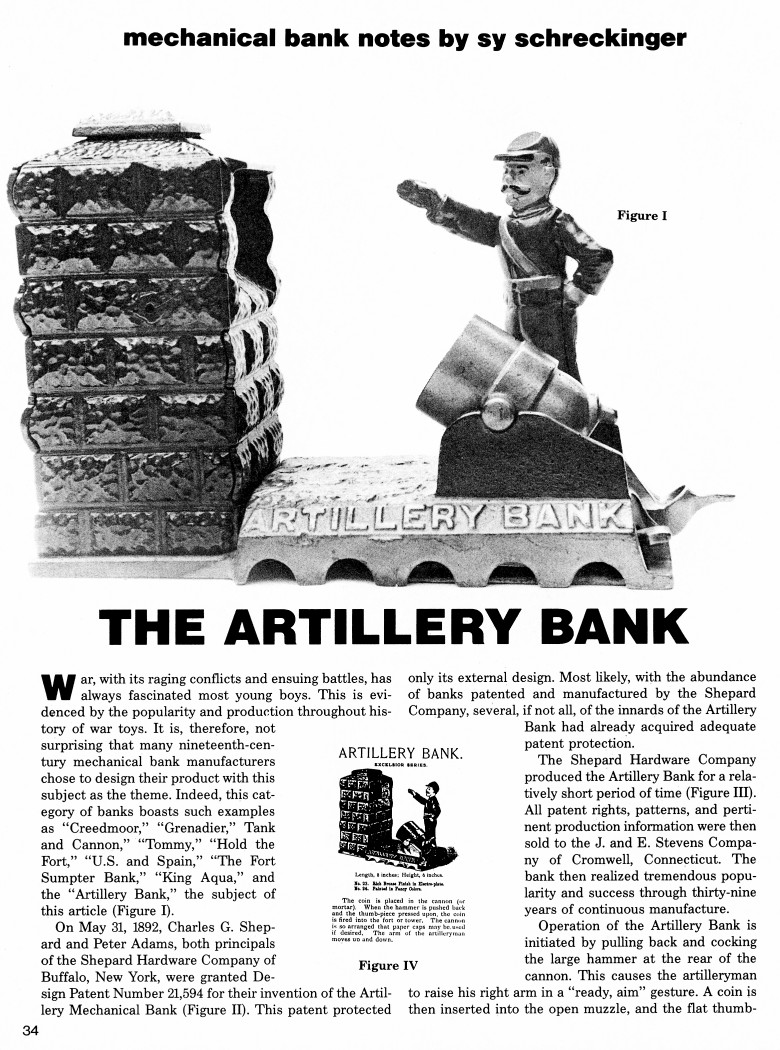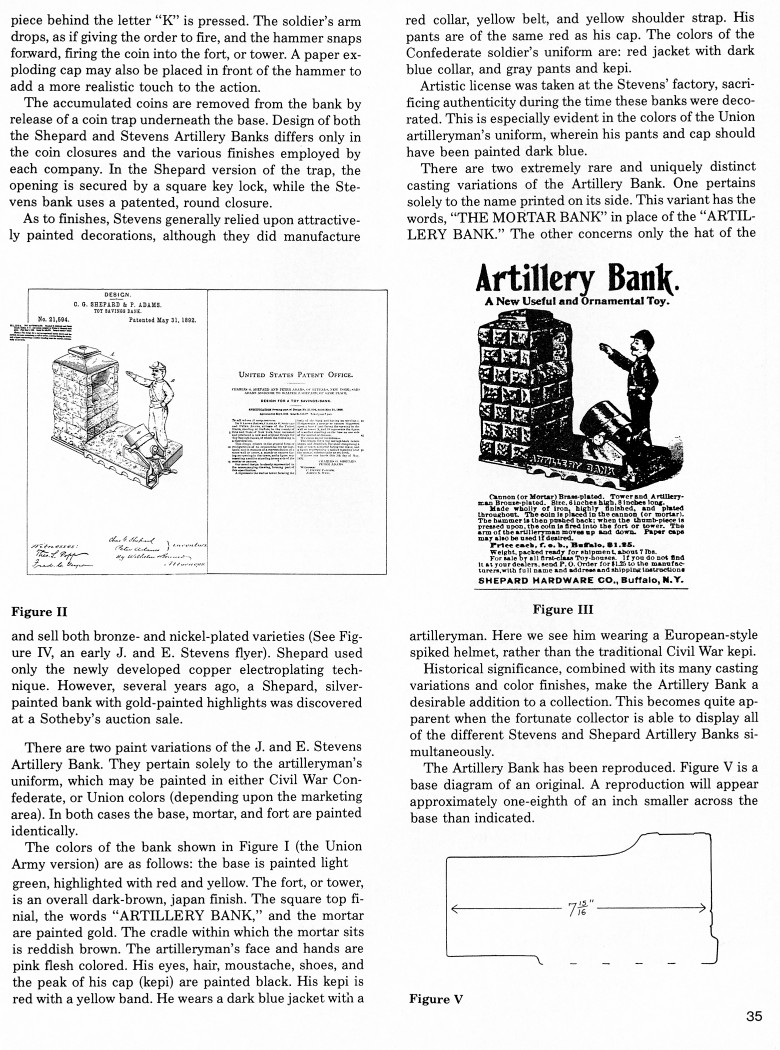|
The Artillery Bank
Sy Schreckinger – ANTIQUE TOY WORLD Magazine – February, 1988
War, with its
raging conflicts and ensuing battles, has always fascinated most young
boys. This is evidenced by the popularity and production throughout
history of war toys. It is, therefore, not surprising that many
nineteenth-century mechanical bank manufacturers chose to design their
product with this subject as the theme. Indeed, this category of banks
boasts such examples as "Creedmoor," "Grenadier," Tank and Cannon,"
"Tommy," "Hold the Fort ... "U.S. and Spain," "The Fort Sumpter Bank,"
"King Aqua," and the "Artillery Bank," the subject of this article (Figure
I).
On May 31, 1892, Charles G. Shepard and Peter Adams, both principals
of the Shepard Hardware Company of Buffalo, New York, were granted Design
Patent Number
21,594 for their invention of the Artillery Mechanical Bank
(Figure II). This patent protected only its external design. Most likely,
with the abundance of banks patented and manufactured by the Shepard
Company, several, if not all, of the innards of the Artillery Bank had
already acquired adequate patent protection.
The Shepard Hardware Company produced the Artillery Bank for a
relatively short period of time (Figure III). All patent rights,
patterns, and pertinent production information were then sold to the J.
and E. Stevens Company of Cromwell, Connecticut. The bank then realized
tremendous popularity and success through thirty-nine years of continuous
manufacture.
Operation of the Artillery Bank is initiated by pulling back and
cocking the large hammer at the rear of the cannon. This causes the
artilleryman to raise his right arm in a "ready, aim" gesture. A coin is
then inserted into the open muzzle, and the flat thumb piece behind the
letter "K" is pressed. The soldier's arm drops, as if giving the order to
fire, and the hammer snaps forward, firing the coin into the fort, or
tower. A paper exploding cap may also be placed in front of the hammer to
add a more realistic touch to the action.
The accumulated coins are removed from the bank by release of a coin
trap underneath the base. Design of both the Shepard and Stevens Artillery
Banks differs only in the coin closures and the various finishes employed
by each company. In the Shepard version of the trap, the opening is
secured by a square key lock, while the Stevens bank uses a patented,
round closure.
As to finishes, Stevens generally relied upon attractively painted
decorations, although they did manufacture and sell both bronze and
nickel-plated varieties (See Figure IV, an early J. and E. Stevens flyer).
Shepard used only the newly developed copper electroplating technique.
However, several years ago, a Shepard, silver-painted bank with
gold-painted highlights was discovered at a Sotheby's auction sale.
There are two paint variations of the J. and E. Stevens Artillery
Bank. They pertain solely to the artilleryman's uniform, which may be
painted in either Civil War Confederate, or Union colors (depending upon
the marketing area). In both cases the base, mortar, and fort are painted
identically.
The colors of the bank shown in Figure I (the Union Army version) are
as follows: the base is painted light green, highlighted with red and
yellow. The fort, or tower, is an overall dark-brown, japan finish. The
square top finial, the words "ARTILLERY BANK," and the mortar are painted
gold. The cradle within which the mortar sits is reddish brown. The
artilleryman's face and hands are pink flesh colored. His eyes, hair,
moustache, shoes, and the peak of his cap (kepi) are painted black. His
kepi is red with a yellow band. He wears a dark blue jacket with a red
collar, yellow belt, and yellow shoulder strap. His pants are of the same
red as his cap. The colors of the Confederate soldier's uniform are: red
jacket with dark blue collar, and gray pants and kepi.
Artistic license was taken at the Stevens' factory, sacrificing
authenticity during the time these banks were decorated. This is
especially evident in the colors of the Union artilleryman's uniform,
wherein his pants and cap should have been painted dark blue.
There are two extremely rare and uniquely distinct casting variations
of the Artillery Bank. One pertains solely to the name printed on its
side. This variant has the words, "THE MORTAR BANK" in place of the
"ARTILLERY BANK." The other concerns only the hat of the artilleryman.
Here we see him wearing a European-style spiked helmet, rather than the
traditional Civil War kepi.
Historical significance, combined with its many casting variations
and color finishes, make the Artillery Bank a desirable addition to a
collection. This becomes quite apparent when the fortunate collector is
able to display all of the different Stevens and Shepard Artillery Banks
simultaneously.
The Artillery Bank has been reproduced. Figure V is a base diagram of
an original. A reproduction will appear approximately one-eighth of an
inch smaller across the base than indicated.
|


